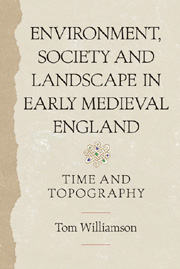Book contents
- Frontmatter
- Contents
- List of Illustrations
- Acknowledgements
- Introduction
- 1 Settlement and Society
- 2 Nature's Frame
- 3 Culture, Ethnicity and Topography
- 4 Small Shires, Deep Roots
- 5 The Gradient of Freedom
- 6 Two Countrysides?
- 7 Village, Farm and Field
- 8 Landscape and Settlement
- 9 Woodland and Pasture
- Conclusion: Time and Topography
- Bibliography
- Index
- ANGLO-SAXON STUDIES
Introduction
Published online by Cambridge University Press: 05 April 2013
- Frontmatter
- Contents
- List of Illustrations
- Acknowledgements
- Introduction
- 1 Settlement and Society
- 2 Nature's Frame
- 3 Culture, Ethnicity and Topography
- 4 Small Shires, Deep Roots
- 5 The Gradient of Freedom
- 6 Two Countrysides?
- 7 Village, Farm and Field
- 8 Landscape and Settlement
- 9 Woodland and Pasture
- Conclusion: Time and Topography
- Bibliography
- Index
- ANGLO-SAXON STUDIES
Summary
This book is about early-medieval settlement in England, and in particular lowland England. It does not purport to be a comprehensive account of this complex and fascinating subject, concentrating instead on a limited number of themes. It examines such matters as why eastern England in the early Middle Ages was distinguished by complex manorial structures and large numbers of free tenants; why the Midland areas of England came to be characterised by landscapes of large villages, and complex and extensive open fields; and why patterns of Anglo-Saxon or Scandinavian influence and settlement took the particular spatial forms that they did. It deals, in short, with questions of regional difference, and attempts to explain some of the most striking geographical patterns in early-medieval England.
Historians and others have often attempted to link various aspects of medieval regional variation, and to establish causal connections between them. Some, for example, have attempted to explain the social idiosyncrasies of eastern England as a consequence of Danish settlement in the ninth century; others have interpreted variations in medieval field systems in terms of the areas settled by particular ethnic groups – Saxons, Jutes, Danes. A long and slightly different tradition has viewed regional variation in both landscape and social institutions as a manifestation of long-term cultural continuities: in G. C. Homans's words, landscapes were ‘the engraving of societies older than written history’.
- Type
- Chapter
- Information
- Environment, Society and Landscape in Early Medieval EnglandTime and Topography, pp. 1 - 5Publisher: Boydell & BrewerPrint publication year: 2012



